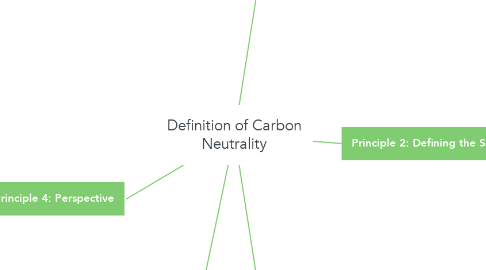
1. Principle 1: CN as means to
1.1. reach net zero emissions
1.1.1. Carbon Trust (2006)
1.1.1.1. Corbett (2009)
1.1.2. Commonwealth of Australia (2019)
1.1.3. Coulter et al. (2008)
1.1.4. DECC (2009)
1.1.5. Gillenwater et al. (2019)
1.1.6. Natural Capital Partners (2017)
1.1.7. Ney and Purman (2009)
1.1.8. Lingl et al. (2010)
1.1.9. UNEP (2009)
1.1.10. UNEP (2014)
1.2. not contribute to climate change
1.2.1. Chiriaco et al. (n.d.)
1.2.2. Gössling (2009)
1.2.3. Johnson (2016)
1.2.4. Lovell et al. (2009)
1.2.5. Pinkse and Busch (2013)
1.2.6. Trexler and Kosloff (2006)
1.3. reach net zero emissions + not contribute to climate change
1.3.1. Carbon Clear (2011)
1.3.2. Burtis and Watt (2008)
1.4. reduce concentration of GHG in the atmosphere
1.4.1. NFGA (2010)
2. Topic Overview Sources
2.1. Burtis and Watt (2008)
2.1.1. Corporate Carbon Neutrality
2.2. Gössling (2009)
2.2.1. Carbon Neutrality in Tourism Industry
2.3. Chiriaco et al. (n.d.)
2.3.1. Sustainable viticulture
2.4. Carbon Trust (2006)
2.5. UNEP (2009)
2.5.1. Carbon neutral life (diet, building, banking etc.) - case studies
2.6. UNEP (2014)
2.7. Natural Capital Partners (2017)
2.7.1. Framework for achieving carbon neutrality
2.8. Coulter et al. (2008)
2.8.1. Report of Carbon Reduction
2.9. NFGA (2010)
2.10. Carbon Clear (2011)
2.10.1. Guide for carbon neutrality
2.11. DECC (2009)
2.12. Commonwealth of Australia (2019)
2.13. Lingl et al. (2010)
2.14. Gillenwater et al. (2019)
2.15. Pinkse and Busch (2013)
2.16. Lovell et al. (2009)
2.17. Johnson (2016)
2.17.1. Carbon neutrality in zoos and aquariums
2.18. Corbett (2009)
2.19. Trexler and Kosloff (2006)
3. Principle 2: Defining the Scope
3.1. GHG protocol Scope 1-3
3.1.1. Burtis and Watt (2008)
3.1.2. Carbon Clear (2011)
3.1.3. Carbon Trust (2006)
3.1.4. Commonwealth of Australia (2019)
3.1.5. Coulter et al. (2008)
3.1.6. DECC (2009)
3.1.7. Gillenwater et al. (2019)
3.1.8. Lingl et al. (2010)
3.1.9. Natural Capital Partners (2017)
3.2. EU ETS Standard
3.2.1. Gössling (2009)
3.2.1.1. CO2 and non-CO2 emissions
3.3. Footprint Assessment
3.3.1. Chiriaco et al. (n.d.)
3.3.2. NFGA (2010)
3.4. ISO 14064
3.4.1. Carbon Trust (2006)
3.4.2. Coulter et al. (2008)
3.4.3. DECC (2009)
3.4.4. Natural Capital Partners (2017)
3.5. PAS 2050
3.5.1. DECC (2009)
3.5.2. Natural Capital Partners (2017)
3.6. The Gold Standard
3.6.1. Coulter et al. (2008)
3.6.2. Lingl et al. (2010)
3.7. Climate Registry’s General Reporting Protocol
3.7.1. Natural Capital Partners (2017)
3.8. Voluntary Carbon Standard (VCS
3.8.1. Coulter et al. (2008)
3.9. Climate, Community and Biodiversity Standards (CCBS)
3.9.1. Coulter et al. (2008)
3.10. The Organisation Standard
3.10.1. Commonwealth of Australia (2019)
4. Principle 3: Approach
4.1. Carbon Offsetting
4.1.1. Ney and Purman (2009)
4.1.2. NFGA (2010)
4.1.3. Pinkse and Busch (2013)
4.2. Carbon Prevention
4.2.1. Chiriaco et al. (n.d.)
4.2.2. Johnson (2016)
4.3. Carbon Prevention + Offsetting
4.3.1. Burtis and Watt (2008)
4.3.2. Carbon Clear (2011)
4.3.3. Carbon Trust (2006)
4.3.4. Commonwealth of Australia (2019)
4.3.5. Coulter et al. (2008)
4.3.6. Corbett (2009)
4.3.7. DECC (2009)
4.3.8. Gillenwater et al. (2019)
4.3.9. Gössling (2009)
4.3.10. Lingl et al. (2010)
4.3.11. Lovell et al. (2009)
4.3.12. Natural Capital Partners (2017)
4.3.13. Trexler and Kosloff (2006)
4.3.14. UNEP (2009
5. Principle 4: Perspective
5.1. System Perspective
5.1.1. Chiriaco et al., n.d.
5.1.2. Burtis and Watt (2008)
5.1.3. Gössling (2009)
5.1.4. Carbon Trust (2006)
5.1.5. Natural Capital Partners (2017)
5.1.6. Coulter et al. (2008)
5.1.7. NFGA (2010)
5.1.8. DECC (2009)
5.1.9. Commonwealth of Australia (2019)
5.1.10. Lingl et al. (2010)
5.1.11. Gillenwater et al. (2019)
5.1.12. Pinkse and Busch (2013)
5.2. Organization Perspective
5.2.1. Ney and Purman (2009)
5.2.2. Johnson (2016)
6. Principle 5: Enabler
6.1. Organization
6.1.1. Burtis and Watt (2008)
6.1.2. Ney and Purman (2009)
6.1.3. Chiriaco et al. (n.d.)
6.1.4. Carbon Trust (2006)
6.1.5. Natural Capital Partners (2017)
6.1.6. Coulter et al. (2008)
6.1.7. NFGA (2010)
6.1.8. Carbon Clear (2011)
6.1.9. DECC (2009)
6.1.10. Lingl et al. (2010)
6.1.11. Gillenwater et al. (2019)
6.1.12. Pinkse and Busch (2013)
6.1.13. Johnson (2016)
6.2. Countries
6.2.1. Gössling (2009)
6.2.2. Commonwealth of Australia (2019)
